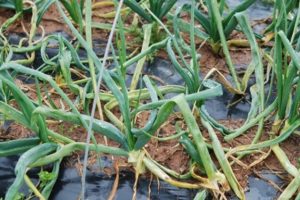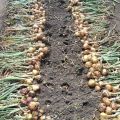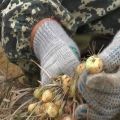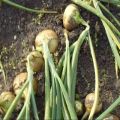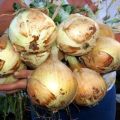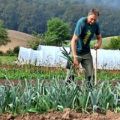How to properly store onions after digging up at home in an apartment so that they do not disappear?
Almost all people who have vegetable gardens are engaged in onion cultivation. After collecting onion heads from the site, many people think about how to store onions. To understand the processing of onions for storage, you need to familiarize yourself with the basic nuances of collecting and preparing the harvested crop for winter.
When to stop watering onions?
Before you store the onion crop and collect it from the site, you need to understand the peculiarities of watering the grown vegetable. Few vegetable growers know that onion heads are distinguished by high keeping quality, which were rarely watered before harvesting.
Before harvesting ripe bulbs, it is recommended to gradually reduce the intensity of soil moisture. Determining when to stop watering is quite simple. To do this, carefully examine the leaves of the bushes, which, after gaining mass, are lined on the surface of the earth. Most often, the period of cessation of watering occurs 2–2.5 months after the onion is planted on the site.
If you do not refuse to further moisten the soil in a timely manner, this will negatively affect the preservation of the crop. Experienced gardeners who know how to preserve onion crops at home say that such vegetables are not stored for a long time in winter.
When to remove onions from the garden?
It is imperative to decide on the most suitable harvest time. Often, gardeners dig up ripe onion heads in the first weeks of August or in the second half of July. However, such terms are not suitable for everyone, since when choosing the exact date, climatic features, weather and the cultivated variety of vegetables are also taken into account.
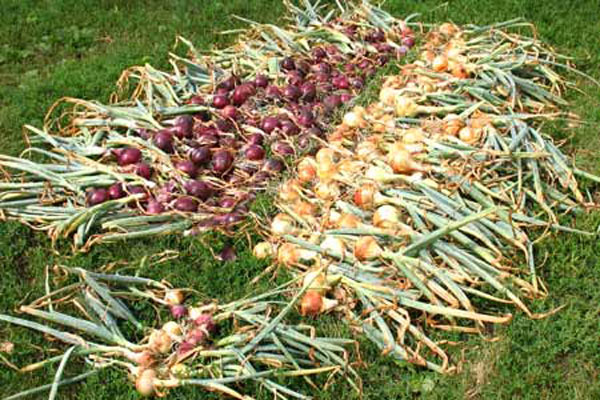
To pinpoint onion harvest time, pay attention to the appearance of the plant. Be sure to inspect the upper part of the root crops, which, when fully ripe, dries up and flakes. You also need to pay attention to the stalks of the vegetable. They should be dry and yellowish. For a visual inspection of the bulbs, you will have to dig in the plant with a pitchfork.
Ripe fruits must be dry and firm.
Some use simple math to determine when to trim and harvest onions. It is no secret that the average time for complete ripening of bulbs is 60–70 days. When determining the date of collection, it is enough to add these figures to the date of planting the vegetable in the garden. However, using this method, one should not forget about the peculiarities of weather conditions. For example, due to a dry summer, the crop is harvested 5-10 days earlier.
Digging and pruning
Having decided on the optimal timing of harvesting and pruning onions, you need to familiarize yourself with the features of this process.However, before that, you should carefully look at the weather forecast for the coming days, since harvesting should be done only in sunny weather. In the absence of rain, the soil will be dry and you will not have to waste time drying the harvested crop.
Digging up the bulbs is quite simple, especially if they are grown in sandy or peaty soil. Most often, difficulties arise when digging up root crops in dense loamy areas. In such cases, a pitchfork is used, as it is easier to dig into dense ground.
When digging out the crop with a pitchfork, a distance of 5-10 cm from the bush is maintained. The top layer of soil is lifted very carefully so as not to accidentally damage the onion head. Often soil sticks to the dug out fruits, which is better to get rid of. If you do not immediately clear the ground, then because of this, the bulbs will begin to rot.
After harvesting, when all the onions have been dug up, you can trim the harvested fruits. During pruning, the roots are carefully cleaned of exfoliated scales and cut off from the leaves. In this case, the leaves must be cut so that a neck 5–7 cm long remains on the head. The roots are also cleaned of the bulbs, which are cut with a knife or ordinary scissors under the bottom.
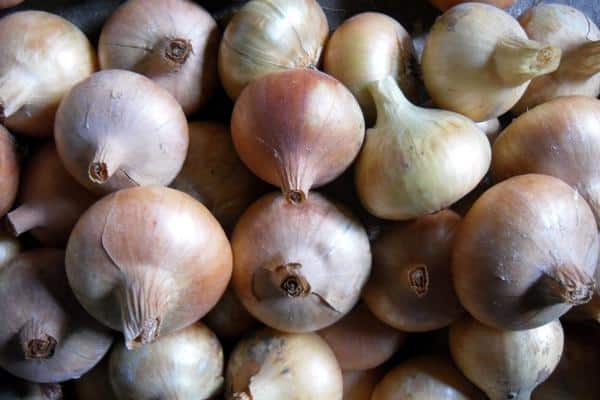
Harvesting onions in the rain
Some people experience adverse weather conditions while harvesting onions for storage. In this case, it is better to familiarize yourself with the features of digging up onion heads in rainy weather.
Digging up onions in the rain is no different from harvesting in sunny weather. You will also have to dig in the soil with a pitchfork or a shovel and carefully remove the roots from the ground. When the entire crop has been dug up, the tubers are brought into a dry room, where they are cleaned of dirt, husks and roots. The peeled bulbs are laid out on the floor and dried out within 7-10 days.
Often, large quantities of onions are dug out of the ground where nitrogen levels are high. In this case, drying is carried out 2-3 times. Only in this way the harvested crop will normally be stored throughout the winter. It is very important that drying is carried out in a room with a temperature of at least 30 degrees Celsius.
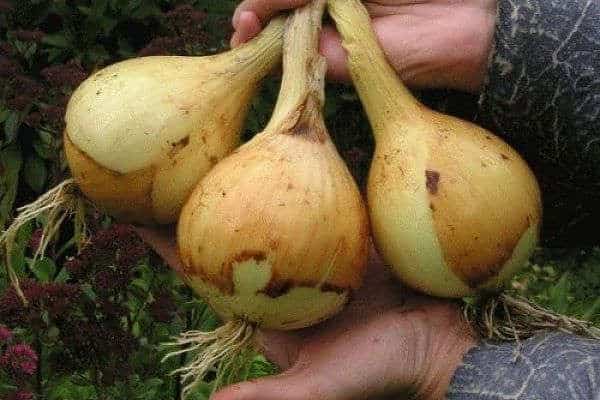
How to dry onions properly?
Before proceeding with the issue of onion storage, you need to familiarize yourself in more detail with the nuances of drying the harvested crop. The shelf life of the heads depends on the correctness and efficiency of drying.
If in the coming days it is sunny and warm outside, then drying can be done directly in the beds. To do this, all the roots are laid out in rows and periodically turned over during the week.
When it rains, the onions laid out to dry are covered with a hanging cover or brought into the room. At the same time, they dry better indoors if they are braided. Some have to dry the vegetable in apartments. For this, preheated ovens or gas stoves are used, over which the harvested crop is suspended. When drying in the oven, be very careful not to spoil the vegetables. It is recommended to regularly monitor the temperature indicators of the oven. Before you dry unpeeled onions for storage, you will have to peel them off.

How to store onions?
After collecting, peeling and drying the green onions, you can start storing them. To do this, you need to figure out in advance where it is best to store onions in the winter.
In the cellar
People living in the private sector prefer to store onions in the basement for the winter. To do this, they use linen bags, baskets and even ordinary wooden boxes. If there are no empty containers for storage, root crops are simply laid out on racks or shelves.
Some, after they have completely prepared the onion for storage, put it in nylon stockings.For this, any tights or nylon stockings that no one is going to wear are suitable. 5-10 onion heads are carefully poured into them, after which the stocking is hung on a hook in the cellar.
For storing vegetables, be sure to use nylon products, as this material is good for air permeability.
In the apartment
The owners of summer cottages often refuse to leave onions in the country for the winter and therefore take the harvested crop to their apartments. Storing heads in such rooms is complicated by space constraints. Unlike a cellar, in living quarters it will not be possible to use boxes or shelves, since they will take up a lot of free space.
Some, to save free space in apartments, braid the harvested crop in braids. However, only uncut plants with leaves are suitable for this. How to store the cut onions so that they do not sprout? To do this, you can use storage nets. In this case, it is recommended to use only nets, and not bags, since there is poor air permeability in fabric bags and therefore the onions quickly fog up.
At the entrance and on the balcony
Sometimes people do not have free space in the apartment and have to leave the entire harvest on the balcony or in the entrance. Store onion heads on the balcony in a special thermo box for vegetables. Without such a container, the crop will begin to rot.
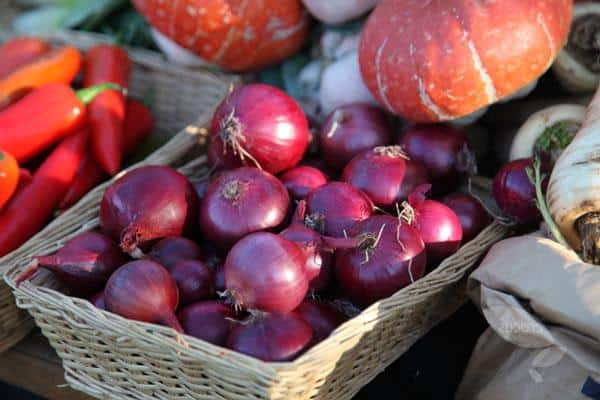
Before placing the bulbs in such conditions, you need to figure out at what temperature they are best stored. All frost-resistant varieties keep well even at temperatures of 1–2 degrees Celsius. For the rest, the room temperature should not drop below 15 degrees.
Looping over and saving
To increase the shelf life of the harvested onion heads, you need to regularly sort out the harvest.
Most often, bulbs are moved, which are in the cellar in winter, since there are the most inappropriate conditions for preserving the harvest. During the sorting of the bulbs, their appearance is carefully examined. If the head begins to darken, it is immediately disposed of as it begins to rot. It is also recommended to remove vegetables with damaged heads during the busting process, since they are not stored for a long time.
Conclusion
Vegetable growers who grow onions often face the problem of storing the harvested heads. In order for the harvested crop to be stored for a long time, you need to familiarize yourself with the features of harvesting and preserving the bulbs.

